Can Solar Wall Lights Replace Traditional Security Lights?
I’ve chatted with plenty of homeowners over the years who stare at their dark side yards or back porches and wonder the same thing: Are solar wall lights tough enough to step in for those beefy wired security floods that scream “back off” to intruders? It’s a fair question, especially with energy bills climbing and everyone eyeing greener setups. Solar wall lights have come a long way—think sleek mounts that charge by day and snap on at dusk—but they’re not always a straight swap for the always-on reliability of hardwired options. They shine (pun intended) in spots where wiring’s a nightmare, but for full-yard coverage? Maybe not solo. Let’s dig into the nuts and bolts so you can figure out if they fit your setup.
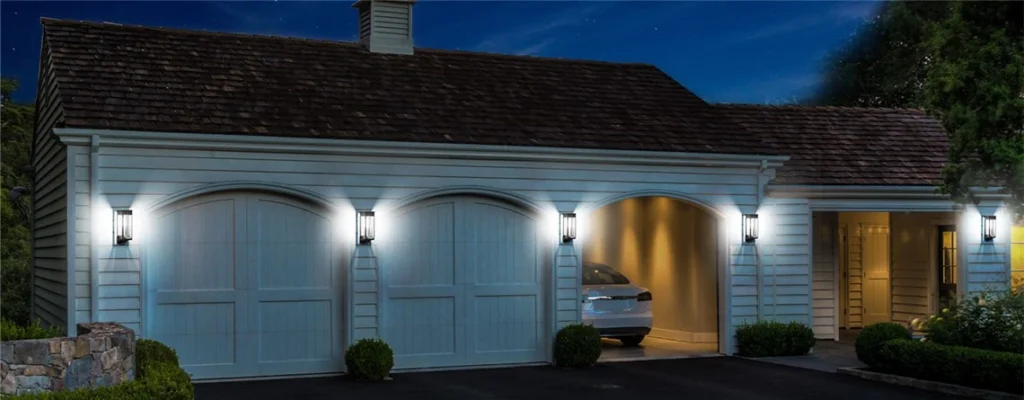
Brightness: Solar Wall Lights vs. Wired Security Floods
When it comes to scaring off prowlers, nothing beats a sudden blast of light that turns night into day. Traditional wired security lights pull straight from your home’s grid, cranking out 1500-3000 lumens or more without breaking a sweat. That’s enough to flood a 20×20-foot driveway or garage door, making every shadow suspect. Solar wall lights? They top out around 400-1500 lumens in most models, which is solid for highlighting a doorway or porch but might leave larger areas feeling underlit. High-end ones like the Maxsa dual-head hit 800 lumens with adjustable beams, but on cloudy days, that output can dip 20-50% if the battery’s not topped off.
The gap comes down to power source: Wired setups don’t care about weather, delivering consistent punch. Solar relies on what the sun dishes out, so expect warmer, more ambient glows (around 3000K) versus the stark 5000K+ of wired floods. For security, solar works if you’re layering lights—say, one per entry point—but won’t match a single wired behemoth for broad deterrence.
Quick brightness breakdown:
- Wired security lights: 1500+ lumens, full power always, ideal for big zones like backyards.
- Solar wall lights: 400-1500 lumens, variable based on charge, best for targeted spots like doors.
- Pro tip: Pair solar with motion activation to amp perceived brightness—sudden on-rush feels more intense than steady light.
In my neighbor’s case, swapping a wired flood for solar walls cut his bill but meant adding two units for the same coverage. It’s a trade-off: Eco wins, but you might need multiples.
Motion Detection: Range and Sensitivity in Action
A light’s only as good as its trigger, and motion sensors are where solar wall lights get clever without the hassle of wiring. Most use PIR (passive infrared) tech, spotting heat changes from people or animals up to 25-35 feet away with a 120-degree sweep. That’s comparable to entry-level wired models, but premium solar ones like the Watchdog II stretch to 35 feet with tweakable sensitivity—no more false alarms from rustling leaves or passing cars. Microwave sensors in fancier setups even peek through walls, though they’re rarer and pricier.
Sensitivity shines here: You can dial it low for windy nights or high for perimeter watch, and many auto-dim to save juice until motion hits. Wired lights often match this range (up to 60 feet in beasts like the LEONLITE), but solar’s edge is placement freedom—no electrician needed for that awkward garage corner. Downside? Cold snaps can fuzz PIR accuracy, dropping range by 10-20%, while wired hum along unfazed.
Sensor specs at a glance:
- Detection range: Solar: 20-35 ft; Wired: 25-60 ft—solar suffices for porches, wired for driveways.
- Angle coverage: Both hit 120-180 degrees; adjust heads on dual-bulb solars for wider arcs.
- Sensitivity tweaks: Solar often wins with simple sliders; avoids over-triggering pets.
One forum user swore by solar walls for his rural fence line—caught a raccoon raid at 30 feet without a hitch. For urban bustle, though, wired’s unflappable.
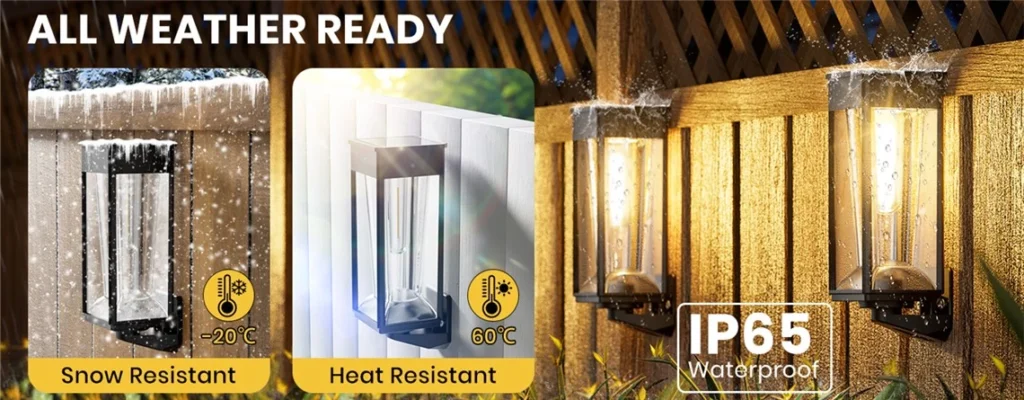
Battery Impact: Powering Through the Night
Solar wall lights live or die by their batteries, and size dictates how long they hold the fort after sunset. Most pack 1200-3000mAh NiMH or LiFePO4 cells, good for 8-12 hours on a full charge—enough for standard nights but tight in winter’s long dark. A 600mAh skimps at 4-6 hours, while 3000mAh beasts push 12+, especially with efficient LEDs sipping just 5-10W. Overnight performance hinges on daytime sun: 6-8 hours direct exposure fills the tank; shade or clouds halve it, forcing dim modes by 2 a.m.
Wired? Infinite runtime, no weather whims. But solar’s smart: Many throttle brightness (e.g., 30% standby, 100% on motion) to stretch batteries, mimicking wired efficiency without the cords. LiFePO4 edges NiMH for cold-weather resilience, holding 80% capacity at freezing temps versus 60%.
Battery runtime factors:
- Capacity tiers: 1200mAh (8 hrs), 2000mAh (10 hrs), 3000mAh (12+ hrs)—bigger means better all-nighters.
- Charge efficiency: South-facing panels at 20-30° angle boost by 40%; clean ’em monthly.
- Mode matters: Motion-only conserves 50% more than constant-on.
A buddy in Seattle tested 2000mAh walls through rainy weeks—still hit 7 hours, but he angles panels roof-ward for max soak. Wired’s unbeatable for reliability, but solar’s close with planning.
Top Scenarios for Solar Wall Lights in Security Roles
Solar wall lights aren’t one-size-fits-all, but they crush it in setups where wires are a pain and eco vibes rule. Think remote spots like sheds or gates—no outlet? No problem, just mount and let the sun do its thing. They’re gold for entryways: A motion-triggered sconce over the side door lights up visitors (or lurkers) without blinding the whole street. Garages and trash bins? Perfect—bright enough to spot hazards or hidey-holes, covering 200 sq ft per unit.
For apartments or rentals, they’re a renter’s dream: Peel-and-stick install, zero landlord drama. Layer ’em along fences or breezeways for perimeter glow, especially with 120° sensors catching fence-jumpers. Avoid vast backyards solo—better as supplements to cameras or wired floods there. In sunny burbs, they’re security MVPs for porches and paths; cloudy climes? Stick to wired for the win.
Prime use cases:
- Front/back doors: Motion sconces for welcoming deterrence—8-10 hrs easy.
- Sheds/garages: Wall floods sans wiring, ideal for off-grid outbuildings.
- Perimeter accents: Along fences or alleys, stacking multiples for chain coverage.
- Trash/recycling zones: Quick light-ups to foil critters or snoopers.
- Rentals/apartments: No-drill mounts for temporary security boosts.
One reviewer lit his alleyway with four solars—caught a package thief on cam, all for under $100. Versatile, but scale to your space.
Making the Switch: Real-World Trade-Offs
Going solar means ditching extension cords and electrician fees, but it’s not plug-and-play perfection. Upfront, solar wall lights run $20-60 a pop versus $50-150 for wired (plus install). Maintenance? Wipe panels quarterly to dodge 20% efficiency loss from grime. And in storms, IP65 ratings shrug off rain, but batteries hate deep freezes—opt for LiFePO4 there.
Hybrids are rising: Some solars add USB backups for grid-tied reliability. For most folks, start small—test a porch pair before yard-wide. It’s empowering to watch your setup hum on sunlight alone, but know the limits.
Solar Wall Lights: Solid for Spot Security, Not Solo Saviors
Solar wall lights absolutely punch above their weight for targeted security, delivering 400-1500 lumens, 25-35 ft motion sweeps, and 8-12 hour batteries that thrive on porches, doors, and sheds—especially where wiring’s off the table. They’re eco-smart, install in minutes, and layer well for renter-friendly glow. But for sprawling yards or unrelenting winters, they falter against wired’s brute-force consistency—pair ’em with cams or floods for the full shield. If your home’s got sunny walls and modest needs, solar’s a no-brainer upgrade. Dive in, tweak as you go, and reclaim those dark corners without the bill shock.

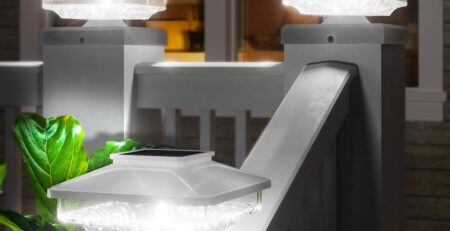
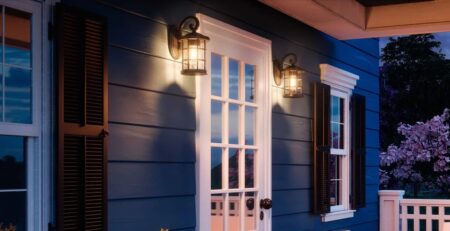




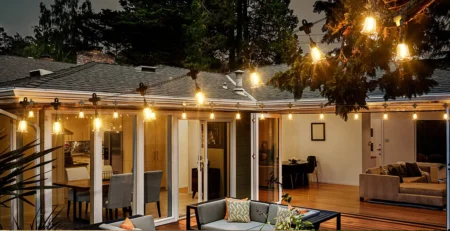
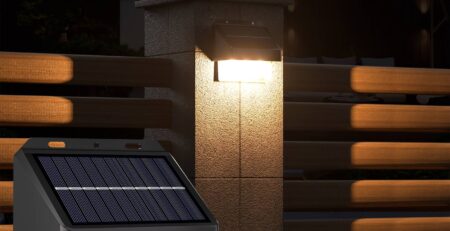
-4-2-450x231.webp)
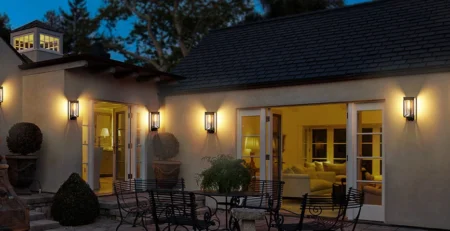
Leave a Reply